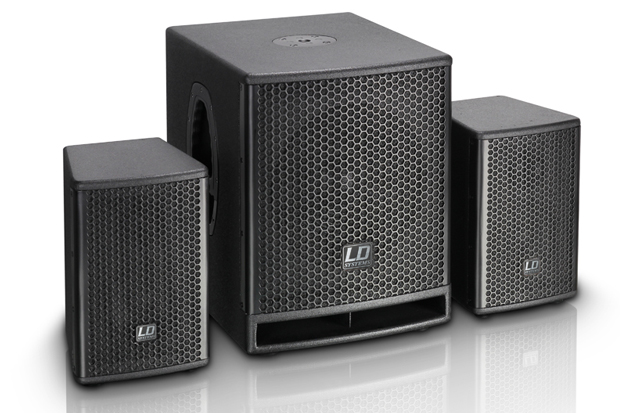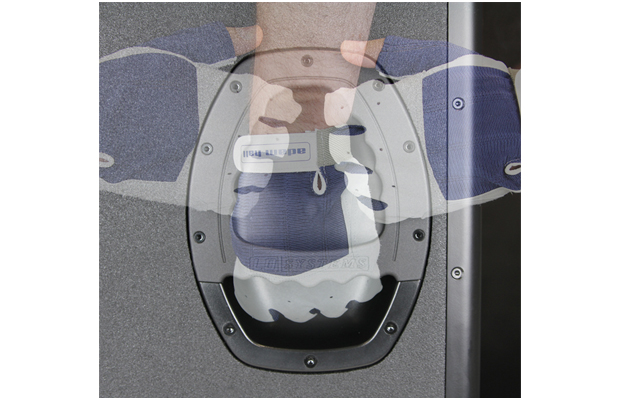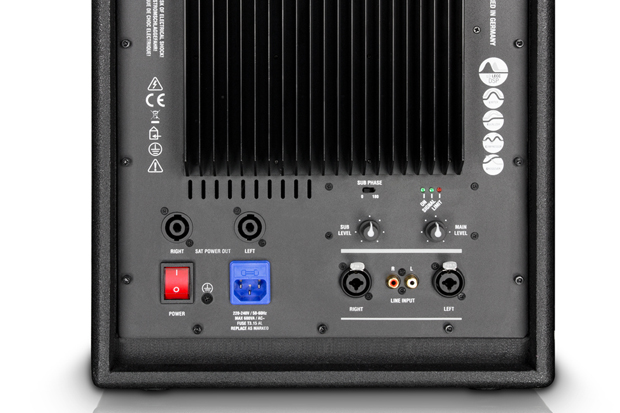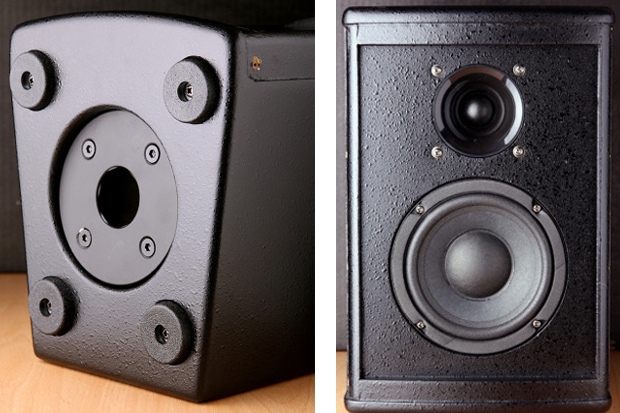LD Systems’ PA system goes into the third generation – Test report by amazona.de
LD Systems has revised its active Dave PA system for the third generation edition and presents it as Dave G. The test features the smallest of the three types: LD Dave 10G³, active 10-inch bass reflex subwoofer with two passive satellite speakers. In addition to the revision of the design, a DSP is now also integrated. The digital signal processor includes optimised crossovers, separate equalizers and limiters for the bass, mid, and treble frequency ranges, and a dynamic compressor that controls the subwoofer according to volume and provides for increased punch at low volumes.  The basic concept of the proven Dave G series has not changed. The complete electronics, also providing the passive satellite sits in the subwoofer. Three power amplifiers deliver a combined performance of 350 watts RMS (700 watts peak). In this respect, 150 watts RMS (300 Watts peak) go to the subwoofer and 100 watts RMS (200 Watts peak) are provided for each of the two-way speakers. This amplifier achieves a sound pressure level of 115 dB (126 dB peak) with a frequency response of 45 Hz to 19 Khz.
The basic concept of the proven Dave G series has not changed. The complete electronics, also providing the passive satellite sits in the subwoofer. Three power amplifiers deliver a combined performance of 350 watts RMS (700 watts peak). In this respect, 150 watts RMS (300 Watts peak) go to the subwoofer and 100 watts RMS (200 Watts peak) are provided for each of the two-way speakers. This amplifier achieves a sound pressure level of 115 dB (126 dB peak) with a frequency response of 45 Hz to 19 Khz.
When compared with its predecessor, the Dave 10G³ has made a significant leap forward, visually speaking. Forget the somewhat brittle charm of the previous version. Uniform looking front panels and a new design for the satellite speakers with carrying handle on the back: the system looks good.
Active Subwoofer
The subwoofer is made from 15 mm MDF and measures 345 x 430 x 460 mm (WxHxD). The surface is coated with a very robust textured paint – incidentally, the same applies for the entire system. Weighing 19.5 kg, the subwoofer is easy to carry. The new, innovative “Evolutive” -handles allow access from all sides. A sturdy perforated metal plate with nylon fabric lining protects the 10 inch bass speaker inside a bass reflex cabinet. The screw mount (M20) for spacer bars can be found on the top.  The afore mentioned LECC DSP for all important system functions is a new feature. The abbreviation stands for limiter, equalizer, compressor, crossover.
The afore mentioned LECC DSP for all important system functions is a new feature. The abbreviation stands for limiter, equalizer, compressor, crossover.
The cooling of the Class A/B power amplifiers is done via a passive heat sink on the back of the subwoofer enclosure. Connectors and controls are located to the rear. The power cord has a self-latching type plug, accidental slipping is thus not possible. The large, illuminated on/off switch shows the switching status. Three LEDs provide information on On, Signal and Limit. The visibility of the LEDs is, however, a bit limited, depending on the observer’s perspective through the cooling fins.
The double inputs come as lockable combo jacks (XLR and 6.3mm jack) and as RCA jacks. Two Speakon® connectors for connecting the satellite speakers are used as outputs. In unfavourable conditions, the sound can become thin; this can be remedied by rotating the subwoofer phase. A small switch, that sometimes can be very useful. The overall volume (Main Level) can be adjusted as can the ratio between the subwoofer and satellites (Sub Level).  Satellites
Satellites
The two closed satellite speakers are compact and lightweight. No wonder, since beyond a passive crossover network, there is no further technology inside these dwarves. The cabinets made from 12 mm MDF are only 200 x 300 x 230 mm (WxHxD) in size, and each speaker weighs only 4 kg. A 5.25 inch midrange driver and a horn with 1 inch driver are incorporated. The impedance of the speaker is 4 ohms. The connection is done via a Speakon connector.
In addition to a well-placed handle on the back panel, the flange is worth mentioning. It is tilted by 5 degrees, so that the boxes on the stand are tilted slightly forward. This can be advantageous when reinforcing the sound at close range. The dispersion of the satellites is 70° x 70° due to the circular horn (see illustration of the open cabinet).  Connected
Connected
The system is quickly connected and up and running. The small satellites can be unobtrusively placed; this can be an invaluable advantage in fixed installations. I’m playing different tracks from a CD player and mixer via the combo inputs; the EQ on the mixer is set to linear. The bass abundance which the subwoofer produces with its 10-inch speaker is amazing. It can be helpful to be able to customise the volume level of the woofer according to taste and song material. The overall sound is good, unobtrusive in the highs. Now the aim is to test the speech playback using an SM58, the classic mic for language and vocals. When using this microphone, the upper mids could be a trifle more present. This effect may vary on other microphones. After a small correction on the EQ, this is no longer an issue and the brilliance is immediately audible. The attainable volume of the system is appropriate, and would be sufficient for a solo entertainer or a duo in a small club.
Conclusion
The newly revised LD Dave 10G³ offers proven technology in a beautiful package. It is the small details that makes this active system a particularly good companion. Firstly, the new DSP for optimised sound reproduction, but also the “Evolutive” handles on the subwoofer or the tilted flange of the satellites. Last but not least, the excellent value for money with a street price of under € 500 is a powerful argument. With its compact dimensions and low weight, the Dave 10G³ is ideal for mobile use (presentations). However, you should always have a mixer in your luggage, because connecting a microphone directly is unfortunately not possible.
Pros
+ compact
+ weight
+ value for money
+ robust surface
+ handles on the subwoofer
+ tilted flange (satellite)
Cons
– visibility of the control LEDs somewhat limited
– microphone not directly connectible
Price
RRP: € 529
For additional information, go to:
http://www.ld-systems.com/en/series/dave-g3-series/
Source: www.amazona.de, Germany, February 2013
Leave a Comment
You must be logged in to post a comment.












